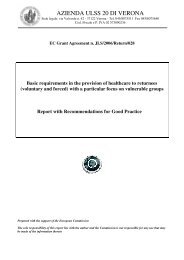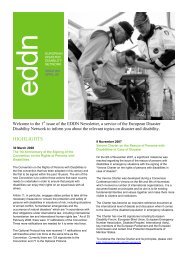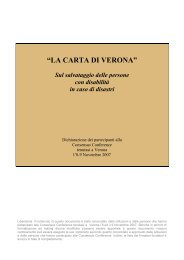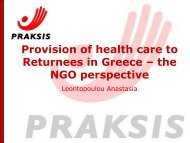DISABILITY & DISASTER
DISABILITY & DISASTER
DISABILITY & DISASTER
Create successful ePaper yourself
Turn your PDF publications into a flip-book with our unique Google optimized e-Paper software.
<strong>DISABILITY</strong> & <strong>DISASTER</strong><br />
The Consensus Conference<br />
Verona Charter<br />
on the rescue of persons with<br />
disabilities in case of disasters<br />
European co-financed project:<br />
“Rescuing Injured Disabled Persons in<br />
Case of Disaster – Civil Protection’s<br />
challenge in the Challenge”<br />
Verona, Italy<br />
November 8-9, 2007<br />
Pia Rockhold, MD, PhD<br />
Sr. Operations Officer<br />
Disability & Development,<br />
Human Development<br />
Network Social Protection &<br />
Labor (HDNSP)<br />
The World Bank<br />
W
Disability and Development and<br />
The World Bank<br />
• Ending world poverty and achieving the<br />
MDGs requires a move towards inclusive<br />
development<br />
• The WB is actively pursuing this, and is<br />
gearing up to support the implementation<br />
of the Convention on the Rights of<br />
Disabled People
UN CONVENTION ON RIGHTS OF<br />
PERSONS WITH DISABILITIES<br />
Bank acted as observer to UN convention drafting<br />
“there should be a clear understanding that in certain cases and<br />
under certain circumstances, Human Rights generate actionable legal<br />
obligations. Such obligations may arise from international treaties, or<br />
from rights enshrined in national laws. Here the Bank’s role is to<br />
support its Members to fulfill those obligations where they relate to<br />
Bank projects and policies”<br />
Ana Palacio, Senior Vice President<br />
World Bank Group General Counsel<br />
2006
Disability Structure at the WB<br />
Human Development Network (HDN)<br />
Social Protection & Labor Sector (HDNSP)<br />
Disability & Development (D&D) Team<br />
Regional Counterparts<br />
Regional Disability Working Group Coordinators<br />
Network Counterparts<br />
Legal, Infrastructure, Environmentally and Socially<br />
Sustainable Development, Information Solutions<br />
Group, Development Economics
Building Partnerships<br />
WB role: facilitating and leveraging<br />
Global Partnership for Disability and Development &<br />
the Multi-Donor Trust Fund for Disability &<br />
Development<br />
• Secured additional $350,000 in GDF financing for<br />
coordination for 2007-8 in April 2007<br />
Joint WHO-World Bank World Report on Disability,<br />
Rehabilitation and Inclusion (started in 2006 to be<br />
launched in 2009)<br />
Washington City Group on Data<br />
• Development Grant Facility also to support workshops and<br />
testing<br />
OECD Disability Statistics on Children & Education<br />
ILO on law and policies
Disability & Development<br />
The World Bank<br />
The Bank’s Disability & Development work:<br />
– Analytical & Operational work<br />
– Strengthening partnerships<br />
– International Convention on the Rights of Persons<br />
with Disabilities<br />
Cross-sectoral awareness raising and training<br />
– World Bank Management & Operational Staff in<br />
Headquarters and Country Offices<br />
– Civil Society<br />
– Client Countries
Disability & Development<br />
The World Bank<br />
Analytical Work themes & Support to Countries:<br />
- Data Collection & Poverty Analysis<br />
- Countries affected by Conflict & Disasters<br />
- Inclusive Health Services (e.g. HIV/AIDS)<br />
- Habilitation & Rehabilitation<br />
- Mental and Psycho-Social Health<br />
- Inclusive Education<br />
- Social protection & Employment<br />
- Inclusive Social Development & Microfinance<br />
- Accessibility of Infrastructure Information and<br />
Communication Technologies
ANALYSIS:<br />
Disability & Disasters<br />
• Disability in Emergency Response: An Analysis of Early<br />
Tsunami Relief Efforts (26 October 2005)<br />
• Disability in conflict-affected countries in Sub-Saharan<br />
Africa (final draft)<br />
• A Function-Based Framework for Emergency<br />
Management and Planning (23 January 2007)<br />
• Fact-finding event on Post Disaster situations:<br />
Opportunities for an Accessible Built Environment (5<br />
December 2005)
Operational Toolkit and<br />
Compendium of Country Access<br />
Laws
The Bank’s respond<br />
disability & disasters<br />
The Bank provide an increasing amount of emergency support to<br />
countries affected by disasters and conflict or to avert pandemics.<br />
The policies and procedures for emergency response have been<br />
adapted to ensure flexibility, timeliness, speed, and effectiveness<br />
and adopt a strategic approach to disaster risk reduction and crisis<br />
prevention in high risk countries.<br />
Recovery program may span several response stages and include<br />
areas outside of the Bank’s traditional core competencies.<br />
Address issues relating to the human, social, and institutional<br />
aspects, such as the reinstatement of essential support and services<br />
to affected people
An increased global demand to<br />
address natural disasters<br />
More than 9000 natural disasters since 1900<br />
About 80 percent within the last 30 years.<br />
But….be ware of the lack of<br />
– standardized definitions &<br />
– collection methodologies<br />
(CRED 2004, IMF 2003)
An increased global demand to<br />
address natural disasters<br />
The Economic costs have increased 15<br />
times since the 1950s amounting to more<br />
than $650 billion in material losses in the<br />
1990s<br />
More than 4 billion people have been<br />
affected by natural disasters during the last<br />
20 years<br />
(CRED 2004, IMF 2003)
Natural disasters 1994 to 2003<br />
Natural disasters cause<br />
high rates of mortality and morbidity<br />
Average annual impact :<br />
58 thousand deaths [range 10 to 123 thousand]<br />
255 million affected [range 68 to 618 million]<br />
(Source: CRED 2004 & IMF, 2003)
One in 25 people worldwide<br />
… survive with physical, mental or psychosocial<br />
and economic devastation”
The Tsunami<br />
Dec 26, 2005
One of the worst natural disasters in modern times.<br />
Magnitude 9.0 on the Richter scale.<br />
More than 200,000 people died.<br />
More than 1.5 million people lost their homes and<br />
livelihoods.<br />
Estimated losses : more than US$ 7 billion<br />
Affected countries: India, Indonesia, Maldives, Sri<br />
Lanka, Somalia, Seychelles, Thailand, Malaysia,<br />
Myanmar.
International Financial Assistance<br />
Public Sources: US$5.3 billion (excl. WB and ADB)<br />
Private contributions: US$1 billion to US$2 billion<br />
WB contribution approx. $672 million (excl. India)<br />
• Indonesia: $246 million<br />
• Maldives: $26 million<br />
• Sri Lanka: $400 million<br />
India: Estimated US$1.5 billion<br />
Estimated financing available through IDA : $300 million.
Core Principles for Tsunami<br />
Recovery Efforts<br />
Country ownership of the reconstruction process<br />
(governments and communities of affected countries)<br />
Recovery programs linked to long-term strategies for<br />
growth and poverty reduction<br />
Coordination among the international community<br />
Rebuilding institutions as well as buildings<br />
Accountability, transparency and effective monitoring of<br />
financial aid.
The World Bank’s Role<br />
1. Provide assistance on the ground in affected countries<br />
for recovery planning (assessment, priorities for<br />
reconstruction)<br />
2. Mobilize financial support<br />
3. Help coordinate rehabilitation and recovery support<br />
4. Reconstruction efforts should not rebuild poverty and<br />
should lessen the impact of future natural disasters.<br />
A concerted World Bank Group-wide effort, also involving<br />
IFC and MIGA, is necessary to meet the broader<br />
reconstruction needs of affected countries.
Damage & Needs assessments<br />
Gather data on physical damage and social impact of the<br />
disaster<br />
Calculate cost of losses<br />
Determine rebuilding costs<br />
Identify most urgent priorities for short-term recovery<br />
Development rebuilding strategies in partnership with<br />
government and communities
PRIORITY NEEDS<br />
1. Restoring lives and livelihoods<br />
2. Restoring the economy<br />
3. Rebuilding the infrastructures<br />
4. Restoring local government
Seizing Opportunities for Change<br />
in reconstruction following disasters<br />
A disaster….<br />
“…can provide a real opportunity for addressing<br />
inequality and ensuring more inclusiveness in the<br />
process of reconstruction by thoughtful planning that is<br />
premised on transforming society and removing barriers.<br />
It will require that reconstruction be people-centered and<br />
participatory if we are serious about achieving equity<br />
and social justice”<br />
-- Charlotte McClain-Nhlapo
The Vulnerability of people living<br />
with Disability & Disasters<br />
Prior to a natural disaster as they are more<br />
likely to be: poor, discriminated & abused,<br />
with poor access to health, education,<br />
livelihood and transport<br />
During …………………..<br />
Post disaster due to possible loss of housing,<br />
caregiver, assistive devices persons or<br />
animals and poor access to relief etc.
Overview of considerations for<br />
developing response<br />
Disaster is a function of the risk process. It results from the combination of<br />
hazards, conditions of vulnerability & insufficient capacity or measures to<br />
reduce the potential negative consequences of risc (UN-ISDR)<br />
• Disaster-Coping mechanisms for people with disabilities at individual level<br />
• Increase awareness of Government, NGO, private sector, relief agencies &<br />
donors focus on the needs of disabled individuals<br />
• Extent and manner of inclusion of people with disabilities during prevention,<br />
mitigation reconstruction process<br />
• Increase in number of disabled individuals and shift in types of disability<br />
following a natural disaster
The Bank’s response<br />
to address disaster<br />
Support to countries to strengthen:<br />
1) disaster prevention, preparedness and mitigation<br />
2) emergency response and relief<br />
3) Recovery and Reconstruction<br />
– Establishment of Hazard Management Unit<br />
(formerly Disaster Mgmt Facility)<br />
– Establishment of Global Facility for Disaster Reduction &<br />
Recovery (GFDRR)<br />
Analyze the situation of people with disability to provide detailed<br />
recommendations for mainstreaming into the overall strategies<br />
Establishing network for warning and evacuation
Key responses<br />
following a disaster<br />
• Socio-cultural needs assessment focusing<br />
on mental, physical and sensory<br />
disabilities<br />
• Ensuring access to health, rehabilitation<br />
(incl. accessibility device), education and<br />
livelihoods<br />
• Inclusive planning/reconstruction<br />
• Coordination of efforts with local DPO and<br />
national and international organizations
Operations:<br />
Mainstreaming disability in disaster response<br />
Turkey<br />
Emergency Earthquake Recovery Loan (EERL)<br />
– Focus on disability: operations that explicitly consider the<br />
needs of people with disabilities.<br />
– Cash Transfer: earthquake victims, survivors, people with<br />
disabilities and newly disabled people<br />
– Outcome: 12.3% of population had a disability in 2002. Benefits<br />
reached these targeted population.
Operations:<br />
Mainstreaming disability in disaster response<br />
India<br />
Gujarat Earthquake (2002) Recovery Program<br />
– Death (20, 000), injuries (167,000)<br />
– Rehabilitation and assistive devices: rehabilitation centers include<br />
prosthetic/orthotic workshop, physiotherapy, occupational therapy,<br />
mobile workshop<br />
– District Primary Education Project TI: specially focuses on the needs<br />
of 620 children with disabilities
Operations:<br />
Mainstreaming disability in disaster response<br />
Iran<br />
Earthquake (2002) Emergency Response Project<br />
– Identification: of particularly vulnerable persons (e.g.<br />
people with disabilities, widows, aged persons living<br />
alone, persons dependent on charity)<br />
– Social Protection: Existing social protection<br />
institutions is to meet the needs of vulnerable people.
Operations:<br />
Mainstreaming disability in disaster response<br />
Pakistan<br />
Earthquake (2007) Disability Project<br />
– Death (73,000), Injuries (70,000)<br />
– Objectives: To enhance service provision to persons with<br />
disabilities & mainstream disability concerns into the development<br />
activities of agencies working on recovery & reconstruction.<br />
– Medical care and specialized rehabilitation: physical or mental<br />
disabilities, post-traumatic stress and trauma<br />
– Community-based rehabilitation: Through contracting NGOs, the<br />
project pilot a CBR approach to rehabilitation, offering a learning<br />
experience for the government’s strategy and build local capacity to<br />
address disability issues.<br />
– Poverty Reduction: The project contribute to long-term objective of<br />
reducing poverty and vulnerability and improving the welfare of<br />
disadvantaged group.
Regional Lessons Learned<br />
– Inclusive development is a multi-stakeholder responsibility<br />
– NGOs, made more effective as delivery of services to the<br />
vulnerable children, through a “contracting” rather than<br />
“grant” approach<br />
– Robust monitoring and evaluation (M&E) system is essential<br />
for learning and accountability<br />
– A learning and innovation lending instrument (LIL) is<br />
effective to pilot and test initiatives, and to build consensus<br />
– Field-based management provides effective, quick response<br />
– Use range of providers to help develop a new strategy for<br />
improving services
Key principles for<br />
inclusive risk management<br />
1. Disability is a transversal criterion. Inclusion of disability can only be<br />
achieved through a holistic “vulnerability” analysis of the entire society.<br />
The aim is to build an inclusive equitable society in which all people are<br />
included in mainstream development and not targeted as vulnerable.<br />
2. Awareness raising about disability issues<br />
3. Non-discrimination<br />
4. Accessibility<br />
5. Involving people with disabilities and their organizations<br />
6. Community Based Rehabilitation:<br />
7. One size does not fit all:
2. Awareness raising<br />
Photo by Ter-Zakaryan Janna, 13, Yerevan, Armenia<br />
People with disabilities are generally not considered,<br />
especially not in a situation of poverty and or disaster.<br />
Lack of awareness about disability issues<br />
makes people with disabilities invisible for those who plan<br />
for the reduction of community vulnerability to natural hazards
3. Non-discrimination<br />
People with disabilities must have the same opportunities to benefit<br />
from programs, services, and activities as people without disabilities
4. Accessibility<br />
People with disabilities should be able to access & use facilities,<br />
services etc. provided within the disaster management framework.<br />
Warning Systems<br />
Relief<br />
100<br />
Aids and Appliances<br />
50<br />
East<br />
Shelters<br />
Sanitation Facilities<br />
Housing<br />
0<br />
1st<br />
Qtr<br />
3rd<br />
Qtr<br />
West<br />
North
5. Involve people with disabilities<br />
& their organizations<br />
in all stages of disaster management<br />
People with disabilities are<br />
the most knowledgeable<br />
about their own needs &<br />
are generally the best<br />
source of expertise on<br />
what does and<br />
does not work<br />
for them.
Mental and Psycho-social Health
Involve people
6. Community Based Rehabilitation<br />
CBR programs strengthen local capacity to act and ensures that<br />
people with disabilities are involved in all disaster related activities<br />
plans, implementation, monitoring and evaluation.
7. One size does not fit all<br />
• People with disabilities do not all have the same<br />
needs and require the same assistance.<br />
• Different types of functional limitations affect<br />
people in different ways.<br />
• Different functional limitations require different<br />
solutions: e.g. some individuals will need<br />
mobility aids, others medication or portable<br />
medical equipment, some a caregiver, service<br />
animals, or information in alternate formats.
Conclusion<br />
• Most major disasters happens in remote areas<br />
of low income countries<br />
• Standardized data collection<br />
• Inclusive risk management<br />
• Prepare civil society for emergencies<br />
• Link short term with long-term development<br />
• Use Information & Technology<br />
• Strengthen & reinforce relevant laws<br />
• Strengthen Inclusive Research
Human Development Network<br />
Social Protection (HDNSP)<br />
www.worldbank.org/sp<br />
HDNSP<br />
Disability & Development (D&D)<br />
www.worldbank.org/disability<br />
Global Partnership on Disability<br />
and Development (GPDD)<br />
www.worldbank.org/disability/gpdd








